Leading market players focus on continuous innovation to introduce cutting-edge technologies and features in their smart beds. This includes advanced sleep tracking capabilities, personalized comfort settings, integration with smart home ecosystems, and the use of AI for intelligent sleep analysis. Market participants are also adopting a variety of strategic activities to grow their global footprint, with important market developments including new product launches, contractual agreements, mergers and acquisitions, Customization and Personalization, higher investments, and collaboration with other organizations. To expand and survive in a more competitive and rising market climate, Smart Bed industry must offer innovative items.
Aggressive marketing campaigns, both online and offline are among the key business tactics used by manufacturers in the global Smart Bed industry to increase the market share. In recent years, the Smart Bed industry has offered some of the most significant advantages to Consumers.
Major players in the Smart Bed market, including Paramount Bed Co., LTD., Arjo AB, Sleep Number Corporation, Ascion, LLC., LINET spol. s r.o., Hi-Interiors srl, Stryker Corporation, The BodiTrak, Hill Rom Holdings Inc., Invacare Corporation, and others, are attempting to increase market demand by investing in product development to increase their product line and cater to diverse consumer needs.
Paramount Bed Group, a distinguished hospital bed manufacturer, has diversified its expertise into elderly care, home care, and health promotion solutions. Renowned for enhancing customers' living environments, the group prioritizes stakeholder dialogue to adapt to changing business landscapes. Guided by unwavering corporate principles, Paramount Bed Group is committed to accurately responding to environmental shifts and contributing meaningfully to society through its comprehensive range of products and services, exemplifying a dedication to improving the well-being of individuals and communities alike.
In February 2022, Paramount Bed Co., Ltd. and Sanko Gakuen have jointly launched a program centered on sleep analysis for care intervention, utilizing Paramount Bed's "Nemuri SCAN" monitoring support system. The initiative is part of the "Care Support Technology (Sleep)" curriculum across seven welfare vocational schools, aiming to develop skilled professionals capable of immediate contributions to the nursing care field.
Arjo, a global leader, prioritizes the empowerment of movement in healthcare, emphasizing quality care. Specializing in patient handling, medical beds, personal hygiene, disinfection, diagnostics, and prevention of pressure injuries and venous thromboembolism, Arjo ensures a safe and dignified healthcare experience. With a dedicated team of over 6000 professionals worldwide and a rich legacy spanning 60 years, the company is steadfast in its commitment to advancing healthier outcomes for individuals confronting mobility challenges. Arjo's comprehensive solutions and products underscore its mission to enhance the well-being of both patients and healthcare professionals.
In September 2023, Arjo launched its Evenda bed range for long-term care




Leave a Comment